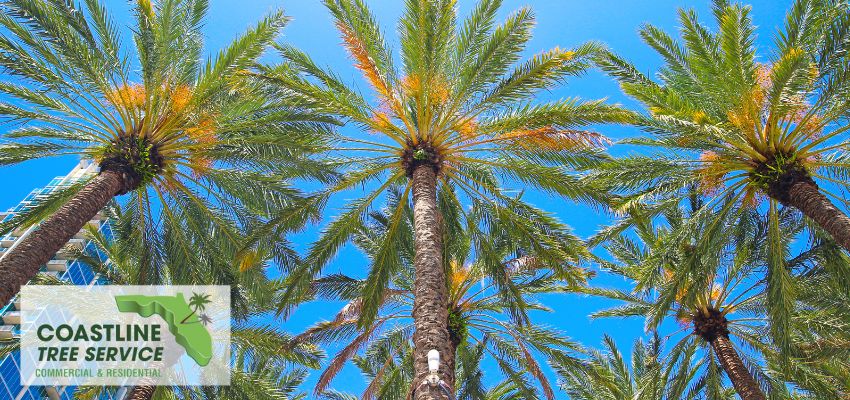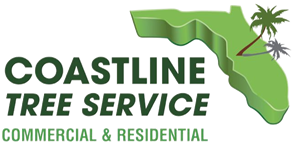
What Exactly Goes Into The Overall Management Of Palm Trees in Florida?
Florida’s tropical climate makes it an ideal environment for the thriving growth of palm trees. However, proper management and care are essential to ensure their health and vitality. Here at Coastline Tree Service, we are tree experts that knows what it takes to manage all species of trees in a residential HOA, especially that of Palm Trees. It requires careful planning, maintenance, and adherence to regulations. In this article, we will explore the key aspects of what one should consider when it comes to the overall palm tree management in Florida, including palm selection, planting techniques, maintenance guidelines encompassing fertilizers, mulching, diseases, pests, and pruning.
1. Palm Tree Selection
Choosing the right palm species is a crucial first step in palm tree management. Factors such as space availability, sun exposure, soil conditions, and cold hardiness should be considered. Some popular palm species suitable for Florida include the Sabal palm, Queen palm, Coconut palm, and Date palm. Our palm tree experts can provide valuable insights and recommendations based on specific environmental conditions within your community and/or property.
2. Planting Guidelines
Proper planting techniques play a vital role in the long-term health and stability of palm trees. The first is to choose a right time of when to plant. For palms dug from a field where root disturbance can be severe, the best time to transplant is the beginning of the warm season (early to late spring depending on location). On the other hand, palms from a container can be planted just about year-round as the roots are usually not disturbed. Consider the following:
- Dig a hole wide and deep enough to accommodate the root ball. The planting hole should be about 18 inches (46cm) wider than root ball. Dig the hole deep enough so that when the root ball is placed in the hole, where the roots emerge from the trunk is about even with the surrounding soil surface or grade.
- Ensure that the tree is planted at the same depth as it was in the nursery container.
- Backfill the hole with amended soil, avoiding air pockets.
- Water thoroughly after planting to promote root establishment. Generally, the goal is to keep the original root ball, backfill, an surrounding site soil evenly moist, not too wet and not too dry. For cooler areas, water 1-2 times a week for 3 months after planting. For warmer climates or during the dry season, water 3-4 times a week until the palm becomes establish or adequate natural rain water is available.
3. Maintenance Guidelines
a. Fertilizing: Palm trees sometimes require regular fertilization to maintain optimal growth and vitality. Depending on the site and species, the fertilization is used to compensate nutrient deficiency, such as nitrogen (yellow old and new fronds), potassium (old fronds with yellow or orange flecking) & magnesium (yellow band around the outside of the fronds) to name a few. Use a slow-release palm fertilizer with a balanced nutrient profile. Apply fertilizer according to package instructions and avoid over-fertilization, which can lead to nutrient imbalances or burn the roots. Here at Coastline Tree Service, our tree experts can help you plan and calculate what exact nutrients/fertilizers your trees need and when is the optimal time in using them.
b. Mulching: Applying a layer of organic mulch around the base of the palm tree provides numerous benefits. Mulch helps retain moisture, suppresses weed growth, and moderates soil temperature. It also helps limit damage from lawn care equipment, conserves water and improves soil structure and condition. Avoid piling mulch against the trunk, as it can create a breeding ground for pests and cause rot.
c. Diseases and Pests: Palm trees are susceptible to various diseases and pests in Florida. Common diseases include Fusarium wilt, Ganoderma butt rot, and lethal yellowing. When we manage your trees, we regularly inspect the palm tree for any signs of disease, such as discoloration or wilting fronds and if we find any potential issues, our on-staff arborist will properly diagnosis the issue and recommend & apply the appropriate treatment.
d. Pruning: Pruning palm trees is essential for maintaining their health and aesthetics. Remove dead or dying fronds regularly to prevent them from becoming a breeding ground for pests or diseases. Avoid excessive pruning, as it can weaken the tree and make it more susceptible to wind damage.
Looking For Additional Help In Helping You Manage Your Palm Trees?
We know what it takes to properly manage all species of trees here in the SW Florida market including that of Palm Trees. Our proven process of palm selection, proper planting techniques, regular fertilization, mulching, disease and pest monitoring, and appropriate pruning practices, have helped many communities in the greater SW Florida enjoy healthy and vibrant palm trees in their respective communities.
So next time you need help with your trees, choose the best in the tree service business – Coastline Tree Service. We provide tree services such as tree trimming, tree removal, tree pruning & tree stump removal services to name a few. Not only do we take care of the trees themselves, but we also ensure the safety of your property.
We proudly serve and offer tree trimming services in Naples, Marco Island, Bonita Springs, Estero, Fort Myers, Fort Myers Beach, Sanibel, Port Charlotte, Punta Gorda, Sarasota, Tampa & all surrounding areas.
Give us a Call at: (239) 895-3230 or contact us online at:https://www.coastlinetree.com/contact-us/
We are your local Tree Service Company in SW Florida.
